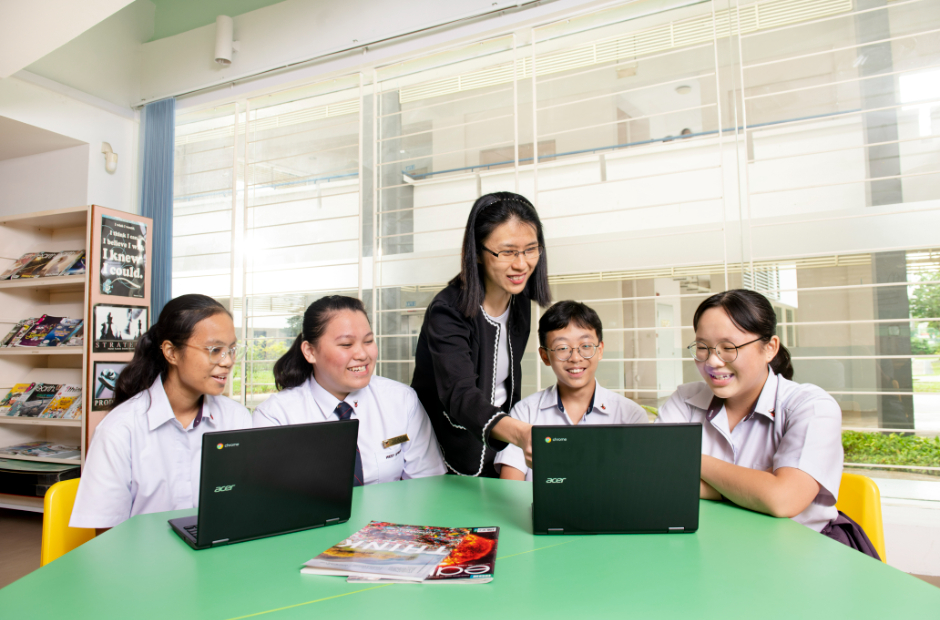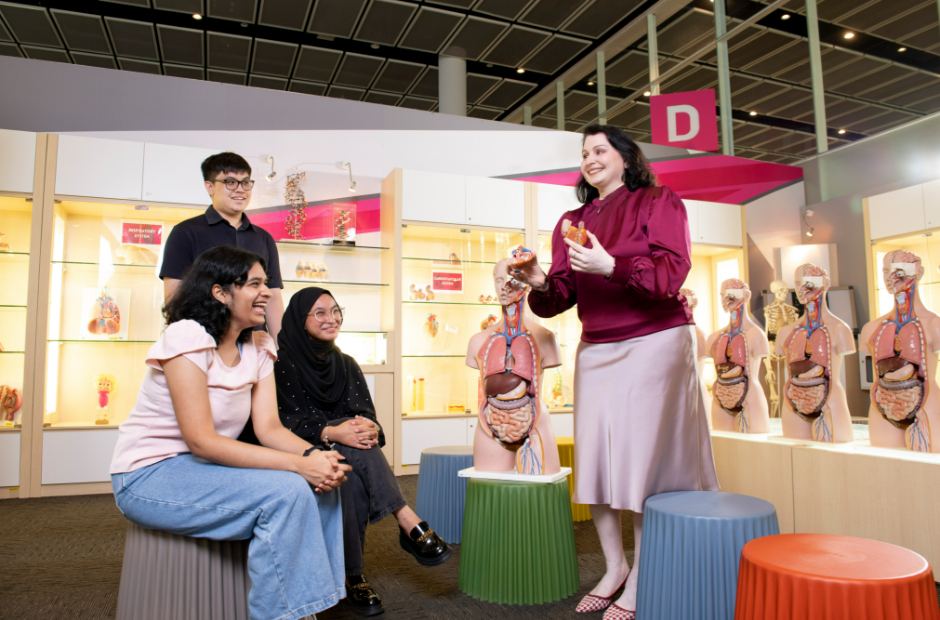Heard of the mixed form class? Here’s how one teacher engages students of different abilities in the same class
12 Sep 2023
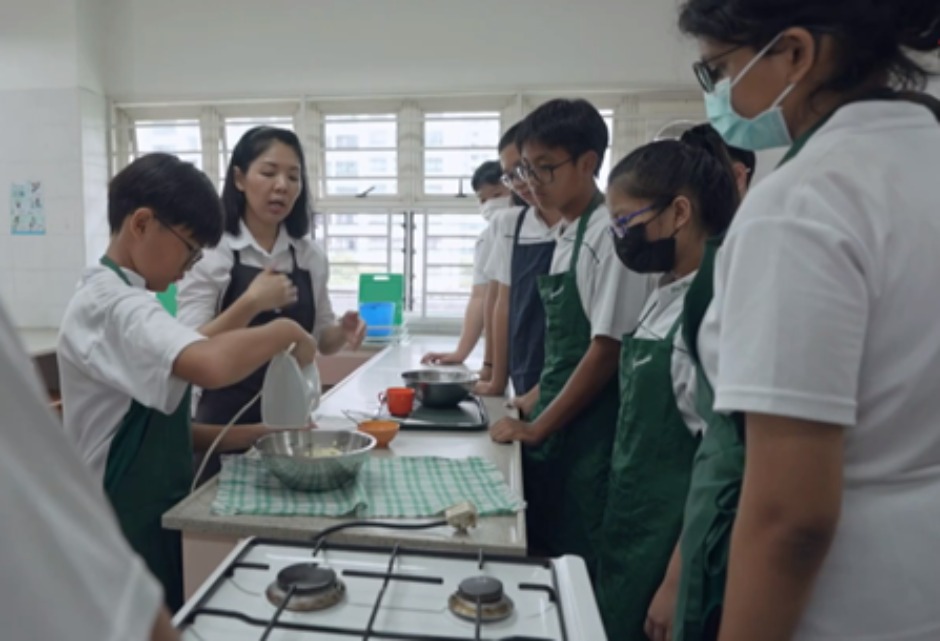
Mixed form classes are going to be the norm as Full Subject-Based Banding is rolled out across all secondary schools by 2024.
What does a class comprising students with varying strengths and interests look like, and how does a teacher bring out the best in all of them?
Using her five favourite phrases, Pei Hwa Secondary School teacher Ong Bee Bee shows Schoolbag how she engages different students differently in her Food and Consumer Education classes.
By Jacquelyn Ng
Students smell the muffins from afar as they arrive at the Home Economics room for their Food & Consumer Education (FCE) lesson.
The trays of baked goods are sitting on Mdm Ong Bee Bee’s desk, a foretaste of what they will be learning to bake in class that day. The mixed form class, taking place at Pei Hwa Secondary School, comprises Secondary Two students from the Normal Technical (NT), Normal Academic (NA) and Express streams.
What is lesson time like in a mixed form class? How does Ms Ong try to engage everyone? Through her five most commonly used phrases in class, we get to know her five strategies for engaging students with a myriad of abilities, interests and learning styles.
#1: “Any questions about the lesson?”
“While it’s not compulsory reading, the number of students who read the materials online before coming to class has increased with each term. I notice that they are encouraged by each other, and want to keep up with their friends. A student went from asking ‘what are we doing next week?’ to asking questions about the topic from the next lesson when I met him along the school corridor.”
Mdm Ong continues, “The pre-readings allow them to digest the material at their own time and pace. When they come to class, they also have a clearer picture of what it is they struggle to understand. Before lessons begin, it is not uncommon to hear them ask their peers about something they read on Google classroom.
“This gives students opportunities to help each other, and allows them to take ownership of their learning.”
#2: “There is more than one way to follow instructions”
Flip open a recipe book and you’ll see a laundry list of ingredients and a series of steps to follow.
“But not everyone might be able to understand it just by reading,” says Mdm Ong, who ensures there is more than one way of relaying information to her students.
For instance, she reads the list of ingredients aloud while flashing it on the screen. She also lays the ingredients out on a tray, and gestures to each item as she introduces it. When students go into baking, a video recording of the baking process is played on loop.
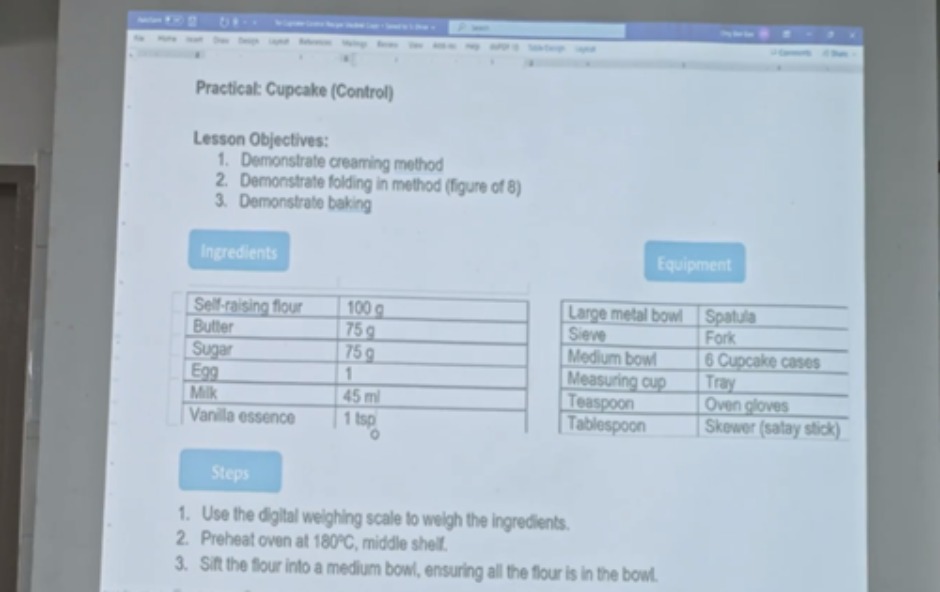
The cupcake recipe is uploaded onto Google Classrooms a few days before the lesson, and flashed on screen while the practical lesson is ongoing.
“In the past, there might have been an overgeneralisation that students from different streams have a learning style ‘better suited’ to their learning needs. Today, because we are stream-blind, we cater to the students based on learning styles – such as visual, auditory or kinesthetics.”
She assesses their learning needs through her interactions with them. “In class, I see how some students brighten up when we watch a video. When students wish to seek clarification on a baking step, some refer to the written recipes while others look at the screen.”
She also differentiates her instructions based on how they respond. “While I might ‘cream the butter and eggs’ to a student confident with baking at home, I will break it down into simpler terms like ‘beat the butter and eggs together at low speed in the mixer’ to one who is less familiar with baking.”
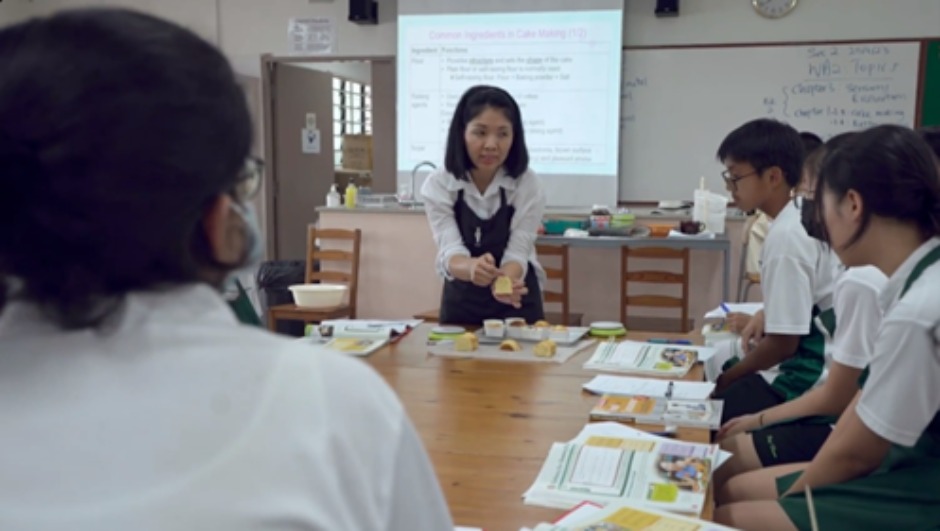
Mdm Ong Bee Bee observes how students respond to her instructions, and breaks it down further for those who might require more help.
#3: “I’ll do, you’ll do, and then we do”
With the progressive model of teaching known as ‘I Do You Do We Do’, Mdm Ong shows the students how to perform a task and gives them a chance to test it out, with support, before they embark on the work themselves.
When muffin-making, Mdm Ong demonstrates how to use the mixer, and students crowd around the teacher’s bench to watch as she beats butter and sugar. They nod, and return to their individual workstations to repeat the task on their own.
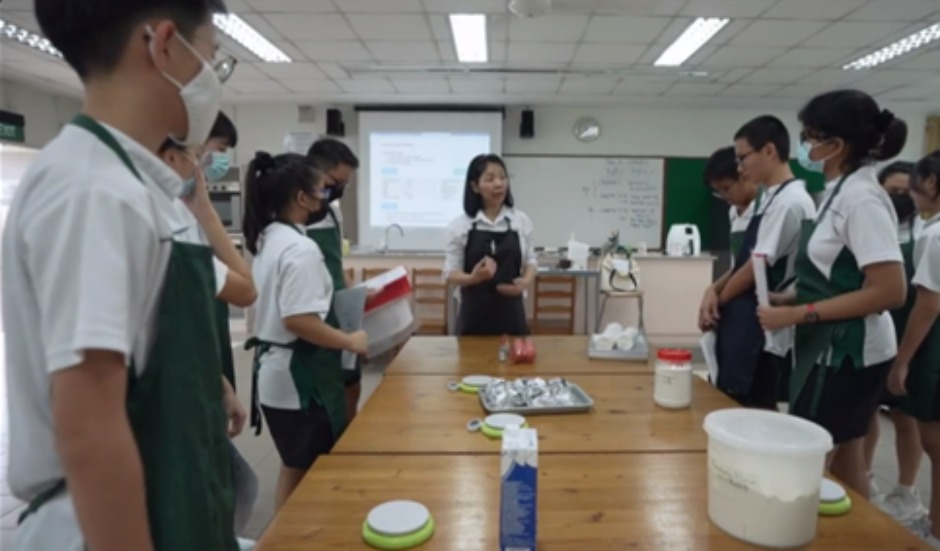
Mdm Ong demonstrating part of the muffin-making process to her students.
When they are familiar with the basic task, the students then break out into groups to perform higher-level tasks such as varying the levels of butter in the recipe. In this lesson, they are examining the effect on different volumes of butter on the outcome of the cake. They confidently tweak the recipe, and bake different batches of the cupcakes over two periods.
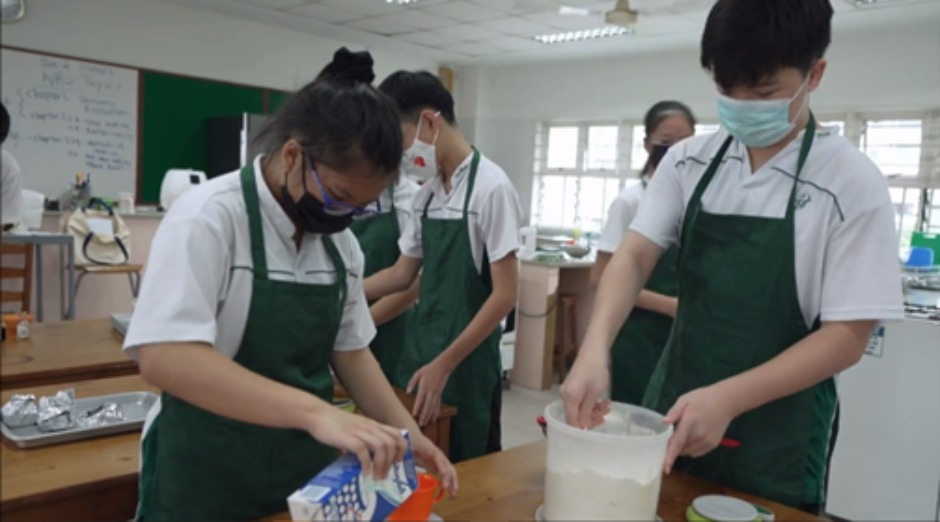
Mdm Ong shares, “This progressive model of learning empowers those who might be less confident. They get an opportunity to see how it’s done, and everyone has a common understanding of baking techniques. I have also observed that those who have more experience in the kitchen also start encouraging their friends, especially when it comes to the more challenging aspects.”
#4: “Ask the expert in your group”
Mdm Ong has one rule in class: Everyone is expected to contribute. No exceptions. Furthermore, we can all learn something from others and multiply our perspectives.
During theory lessons, students have the chance to contribute to one another’s learning through group work, and take turns being “experts”.
How this works is, within each group of four, students are numbered and assigned a role of teaching something to the rest of their peers. For instance, those numbered ‘1’ may be assigned as “experts” in the functions of carbohydrates. All the ‘1s’ would then research on their own before coming together as an ‘expert group’ to share their learning, before bringing their conclusions back to their original groups.
“This process of learning together, and subsequently teaching someone else, helps with knowledge retention. It also gives everyone a chance to contribute, ask questions, and offer respect, no matter your ability.”
#5: “How well do you understand this?”
Mdm Ong uses pre-assessment quizzes to identify gaps in her students’ understanding of a topic. She then dedicates more of her lesson time to these areas, effectively customising learning for the class.
When it comes to assessment time, students can also choose how they would like to be assessed. “This can be done through a skit, podcast, posters… or even a TikTok video,” says Mdm Ong. “Some students who are more confident and articulate might opt for a video option. Those who prefer working with pen and paper could design posters as their final product.”
“What the teachers are looking out for is an understanding of the topic, instead of a just regurgitating model answers.”
It gives everyone a chance to demonstrate their talents in their own way. “I’ve seen how students appreciate each other’s strengths as a result. Some willingly stay back after class to learn new skills from their friends, such as designing sleek PowerPoint slides. Instead of identifying each other based on stream, they are recognised by their skills and eagerness to offer help.”
At the end of the day, Mdm Ong shares that the above strategies are not unique to Full SBB classrooms, but are her curation of strategies that work well for mixed form classes, which are an extension of what happens in real-world group situations.
“You’ll see a lot more cooperation between the students. I’ve seen friendships develop between those from different streams, and these carry on post-graduation. This makes me the happiest.”
From 2024, streaming will be phased out and replaced by Full Subject-Based Banding in schools. This is part of MOE’s efforts to nurture the joy of learning and better cater to the different strengths and interests of our students.
Pei Hwa Secondary School adopted Full Subject-Based Banding early in 2020 and introduced mixed form classes in the process. Each class comprises students from different streams, who learn six common subjects together – Art, Music, Physical Education, Design & Technology (D&T), Character & Citizenship Education (CCE), and FCE. The students are grouped according to their stream for other subjects; later cohorts not affected by streaming are grouped according to their ability level per subject.
Find out more about what this means for students, parents and teachers on CNA Insider’s ‘A New School of Thought – Full SBB at go.gov.sg/anewschoolofthought.
We are on Telegram! Subscribe to our channel: https://t.me/schoolbag_edu_sg



